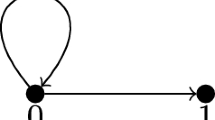Abstract
A relativized version of Tarski’s T-scheme is introduced as a new principle of the truth predicate. Under the relativized T-scheme, the paradoxical objects, such as the Liar sentence and Jourdain’s card sequence, are found to have certain relative contradictoriness. That is, they are contradictory only in some frames in the sense that any valuation admissible for them in these frames will lead to a contradiction. It is proved that for any positive integer n, the n-jump liar sentence is contradictory in and only in those frames containing at least an n-jump odd cycle. In particular, the Liar sentence is contradictory in and only in those frames containing at least an odd cycle. The Liar sentence is also proved to be less contradictory than Jourdain’s card sequence: the latter must be contradictory in those frames where the former is so, but not vice versa. Generally, the relative contradictoriness is the common characteristic of the paradoxical objects, but different paradoxical objects may have different relative contradictoriness.
Similar content being viewed by others
References
Boolos G.: Logic of Provability. Cambridge University Press, Cambridge (1993)
Chihara C.: ‘The semantic paradoxes: A diagnostic investigation’. The Philosophical Review 88(4), 590–618 (1979)
Diestel R.: Graph Theory, 2nd. edn., Graduate Texts in Mathematics. Springer-Verlag, New York (2000)
Gupta, A., ‘Truth and paradox’, Journal of Philosophical Logic, 11 (1982), 1–60. Reprinted in [11], pp. 175-235.
Gupta A., Belnap N.: The Revision Theory of Truth. MIT Press, Cambridge (1993)
Halbach V., Leitgeb H., Welch P.: ‘Possible-worlds semantics for modal notions conceived as predicates’. Journal of Philosophical Logic 32(2), 179–223 (2003)
Herzberger H.G.: ‘Naive semantics and the Liar paradox’. Journal of Philosophy 79, 479–497 (1982)
Herzberger, H. G., ‘Notes on naive semantics’, Journal of Philosophical Logic, 11 (1982), 61–102. Reprinted in [11], pp. 133-174.
Kripke, S. A., ‘Outline of a theory of truth’, Journal of Philosophy, 72 (1975), 19, 690–712. Reprinted in [11], pp. 53-82.
Leitgeb H.: ‘Truth as translation – part A, part B’. Journal of Philosophical Logic 30(281–307), 309–328 (2001)
Martin R.L.: Recent Essays on Truth and the Liar Paradox. Oxford University Press, Oxford (1984)
Priest G.: ‘Yablo’s paradox’. Analysis 57(4), 236–242 (1997)
William N., William N.: ‘Necessity predicates and operators’. Journal of Philosophical Logic 9(4), 437–450 (1980)
Tarski, A., ‘The concept of truth in formalized languages’, Studia Philosophica, 1 (1936), 261–405. Also in [15], pp. 152-278.
Tarski A.: Logic, semantics, metamathematics: papers from 1923 to 1938. Clarendon Press, Oxford (1956)
Tarski, A., ‘The semantic conception of truth and the foundations of semantics’, in S. Blackburn, and K. Simmons, (eds.), Truth, Oxford Readings in Philosophy, Oxford University Press, New York, 1999, pp. 115–143.
Yablo S.: ‘Paradox without self-reference’. Analysis 53, 251–252 (1993)
Yablo, S., ‘Circularity and paradox’, in V. F. Hendricks T. Bolander, and S. A. Pedersen, (eds.), Self-Reference, CSLI Publications, 2004, pp. 139–157.
Author information
Authors and Affiliations
Corresponding author
Rights and permissions
About this article
Cite this article
Hsiung, M. Jump Liars and Jourdain’s Card via the Relativized T-scheme. Stud Logica 91, 239–271 (2009). https://doi.org/10.1007/s11225-009-9174-5
Received:
Accepted:
Published:
Issue Date:
DOI: https://doi.org/10.1007/s11225-009-9174-5



